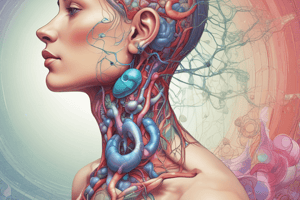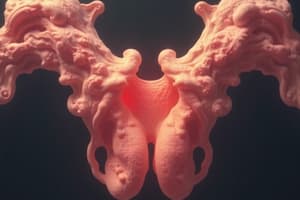Podcast
Questions and Answers
A newborn presents with neonatal hyperthyroidism. Which maternal condition is the most likely cause?
A newborn presents with neonatal hyperthyroidism. Which maternal condition is the most likely cause?
- Secondary hyperthyroidism
- Thyrotoxicosis factitia
- Hashimoto's thyroiditis
- Grave's disease (correct)
A patient with hyperthyroidism experiences weight loss despite increased appetite. What physiological process primarily explains this?
A patient with hyperthyroidism experiences weight loss despite increased appetite. What physiological process primarily explains this?
- Increased basal metabolic rate (correct)
- Increased leptin sensitivity
- Decreased intestinal absorption
- Insulin resistance
A patient presents with tachycardia, goiter, and exophthalmos. Which condition is most likely?
A patient presents with tachycardia, goiter, and exophthalmos. Which condition is most likely?
- Thyroid storm
- Secondary hyperthyroidism
- Follicular carcinoma
- Grave's disease (correct)
In primary hyperthyroidism, what laboratory findings would you expect to see?
In primary hyperthyroidism, what laboratory findings would you expect to see?
A patient is diagnosed with secondary hyperthyroidism. What is the most likely underlying cause?
A patient is diagnosed with secondary hyperthyroidism. What is the most likely underlying cause?
Which of the following is NOT a typical symptom of a thyroid storm?
Which of the following is NOT a typical symptom of a thyroid storm?
A patient experiencing a thyroid storm is being treated with propylthiouracil. What is the primary mechanism of action of this medication in this context?
A patient experiencing a thyroid storm is being treated with propylthiouracil. What is the primary mechanism of action of this medication in this context?
Which diagnostic procedure is considered the basic method for evaluating thyroid nodules in hyperthyroidism?
Which diagnostic procedure is considered the basic method for evaluating thyroid nodules in hyperthyroidism?
A patient with long-standing, untreated hyperthyroidism is at increased risk for which of the following complications?
A patient with long-standing, untreated hyperthyroidism is at increased risk for which of the following complications?
Which medication is used during thyroid storm to treat cardiovascular problems?
Which medication is used during thyroid storm to treat cardiovascular problems?
In the hypothalamic-pituitary-thyroid (HPT) axis, what is the direct effect of thyroid-stimulating hormone (TSH) on the thyroid gland?
In the hypothalamic-pituitary-thyroid (HPT) axis, what is the direct effect of thyroid-stimulating hormone (TSH) on the thyroid gland?
How does T3, the active form of thyroid hormone, primarily affect a cell's basal metabolic rate?
How does T3, the active form of thyroid hormone, primarily affect a cell's basal metabolic rate?
Which of the following is a characteristic physiological effect of thyroid hormone on the skeletal system?
Which of the following is a characteristic physiological effect of thyroid hormone on the skeletal system?
What is the underlying mechanism of Grave's disease that leads to hyperthyroidism?
What is the underlying mechanism of Grave's disease that leads to hyperthyroidism?
How does hyperthyroidism affect the sympathetic nervous system?
How does hyperthyroidism affect the sympathetic nervous system?
What is the primary cause of Jod-Basedow syndrome (iodine-induced thyrotoxicosis)?
What is the primary cause of Jod-Basedow syndrome (iodine-induced thyrotoxicosis)?
Which of the following is the direct mechanism by which thyroid inflammation can lead to hyperthyroidism?
Which of the following is the direct mechanism by which thyroid inflammation can lead to hyperthyroidism?
In the context of thyroid hormone action, what is the role of plasma proteins in the blood?
In the context of thyroid hormone action, what is the role of plasma proteins in the blood?
Flashcards
HPT Axis
HPT Axis
A regulatory system involving the hypothalamus, pituitary gland, and thyroid gland that maintains thyroid hormone levels through negative feedback.
Thyroid-Stimulating Hormone (TSH)
Thyroid-Stimulating Hormone (TSH)
A hormone that stimulates the thyroid gland to produce thyroid hormones (T3 & T4).
Thyroid Disorders
Thyroid Disorders
Disorders of the thyroid gland, the most common endocrine issue.
Follicular Cells
Follicular Cells
Signup and view all the flashcards
Hyperthyroidism
Hyperthyroidism
Signup and view all the flashcards
Primary Hyperthyroidism
Primary Hyperthyroidism
Signup and view all the flashcards
Grave's Disease
Grave's Disease
Signup and view all the flashcards
Jöd-Basedow Syndrome
Jöd-Basedow Syndrome
Signup and view all the flashcards
Neonatal Hyperthyroidism
Neonatal Hyperthyroidism
Signup and view all the flashcards
Secondary Hyperthyroidism
Secondary Hyperthyroidism
Signup and view all the flashcards
Cardiological Signs of Hyperthyroidism
Cardiological Signs of Hyperthyroidism
Signup and view all the flashcards
Common Hyperthyroidism Symptoms
Common Hyperthyroidism Symptoms
Signup and view all the flashcards
Grave's Disease Characteristics
Grave's Disease Characteristics
Signup and view all the flashcards
Endocrine Orbitopathy
Endocrine Orbitopathy
Signup and view all the flashcards
Diagnosing Hyperthyroidism
Diagnosing Hyperthyroidism
Signup and view all the flashcards
Hyperthyroidism Treatment
Hyperthyroidism Treatment
Signup and view all the flashcards
Thyroid Storm
Thyroid Storm
Signup and view all the flashcards
Symptoms of Thyroid Storm
Symptoms of Thyroid Storm
Signup and view all the flashcards
Study Notes
- The hypothalamic-pituitary-thyroid (HPT) axis operates on a negative feedback loop
- The hypothalamus releases thyrotropin-releasing hormone (TRH) when it detects low thyroid hormone levels
- TRH travels through the hypophyseal portal system to the anterior pituitary
- The anterior pituitary then releases thyroid-stimulating hormone (TSH), also known as thyrotropin
- TSH stimulates the thyroid gland to release thyroid hormones
Thyroid Gland
- Thyroid disorders represent the most common endocrinopathies
- The thyroid comprises thousands of follicles lined with follicular cells
- Follicular cells convert thyroglobulin into T3 or T4
- Once released, these hormones bind to plasma proteins in the blood, leaving only a small fraction unbound
- Inside cells, T4 converts to T3, which speeds up the cell's basal metabolic rate
- As a result, cells produce more proteins and burn more energy in the form of sugars and fats, increasing cardiac output
- Thyroid hormone also stimulates bone resorption and activates the sympathetic nervous system
- Gluconeogenesis, fatty acid synthesis (B-oxidation) in the liver, and lipolysis in adipose tissue are subsequently activated
Hyperthyroidism
- Hyperthyroidism involves an excess of thyroid hormones, leading to a hypermetabolic state
- Primary hyperthyroidism stems from issues with the thyroid gland itself producing excess hormones
- Secondary hyperthyroidism results from problems with the pituitary gland or hypothalamus, causing higher TSH production
Primary Hyperthyroidism
- Grave’s disease represents the most common cause
- Grave's disease is an autoimmune disorder where B-cells produce antibodies against thyroid proteins
- Thyroid-stimulating immunoglobulins bind to TSH receptors on follicular cells that mimic TSH
- This results in growth of the thyroid gland and production of excess thyroid hormone
- Toxic nodular goiter (toxic adenoma) occurs when one or more follicles generate excessive thyroid hormones
- Hyperfunctioning thyroid adenoma involves follicular cells growing uncontrollably, forming a benign tumor and making excess thyroid hormones
- Jöd-Basedow syndrome (iodine-induced thyrotoxicosis) can develop after an iodine-deficient person receives a large dose of iodine
- Thyroid inflammation can cause a large release of pre-formed thyroid hormones
- Neonatal hyperthyroidism occurs when newborns of mothers with Grave’s disease produce excess thyroid hormone due to thyroid-stimulating immunoglobulin crossing the placenta
Other Causes of Hyperthyroidism
- Follicular carcinoma
- Thyrotoxicosis factitia
- Paraneoplastic hyperthyroidism (embryonal carcinoma of testes, mole hydatidosa = molar pregnancy)
Secondary Hyperthyroidism
- Pituitary thyrotropic adenoma causes higher TSH production when thyroid gland is normal
- The thyroid gland generates a lot of thyroid hormone in response to a TSH-secreting tumor in the anterior pituitary
Symptoms of Hyperthyroidism
- Cardiological signs include tachycardia, hypertension, palpitations, extrasystoles, a. fib., and thyrotoxic cardiomyopathy
- Skin symptoms include moist, sweaty skin, radiant palms, and fine hair, and head hair loss
- Diarrhea
- Weight loss despite good appetite due to higher basal metabolic rate, although 10% of patients gain weight
- Heat intolerance because the body if producing more heat
- Menstrual irregularities may also occur
- Characteristics of Grave’s disease include
- Tachycardia, goiter, exophthalmos, a diffusely enlarged soft thyroid gland that can pulsate, and a tactile vortex may be present.
- Endocrine orbitopathy manifests as exophthalmos along with Moebius, Graefe, and Dalrymple signs, and lagophthalmos
- Long-term hyperthyroidism can lead to congestive heart failure and osteoporosis
Diagnosis of Hyperthyroidism
- Confirmed by thyroid function tests measuring TSH activity and free T4
- Increased free T4 with decreased TSH indicates primary hyperthyroidism.
- Increased free T4 with increased (or normal) TSH indicates secondary hyperthyroidism and thyrotropic pituitary adenoma
- Specific antibodies, such as anti-TSH-receptor antibodies in Grave’s disease, or calcitonin and cholesterol levels can be measured
- Ultrasound and aspiration biopsy with a thin needle with cytological examination is the basic diagnostic procedure
- Scintigraphy and CT examination are performed if malignancy or toxic adenoma are suspected
Treatment of Hyperthyroidism
- Treatment depends on the cause, but generally includes drugs like beta blockers to treat immediate symptoms
- Anti-thyroid drugs block thyroid hormone production and release, eg, propul-thio-uracil
- Radioiodine therapy destroys the thyroid partially or completely, followed by replacement hormone therapy
- In a few cases, the thyroid is removed with surgery (subtotal thyroidectomy)
Thyroid Storm
- Thyroid storm involves increased activity of thyroid hormones stemming from untreated or poorly treated hyperthyroidism
- Associated factors: infection, injury, amiodarone use, interruption of thyrostatic treatment, and iodine preparations exposure.
- Escalated hyperthyroidism symptoms can endanger the patient’s life, with mortality rates between 30-50%
- Common symptoms include fever, heat intolerance, sweating, tachycardia, atrial fibrillation, palpitations, nausea, diarrhea, abdominal pain, and neuropsychological changes (agitation, delirium, tremor, or convulsions)
- Diagnosis involves characteristic findings in laboratory parameters which are increased of free T4 and T3 values, and a decrease in TSH
Treatment of Thyroid Storm
- Administer thyrostatics (propylthiouracil, thiamazole) to inhibit the increased synthesis and release of thyroid hormones, potassium iodide (slows the release of thyroid hormones), hydrocortisone
- Beta blockers for cardiovascular problems, paracetamol or physical cooling to reduce temperature, oxygen therapy, and rehydration
- Total thyroidectomy is an important treatment option for difficult-to-manage thyrotoxic crisis
- Osmosis: The thyroid storm is a life-threatening complication of hyperthyroidism where the body goes into a state of severe hypermetabolism
- It can develop when someone with hyperthyroidism stops their treatment, develops an infection, or has surgery
- All of the normal symptoms of hyperthyroidism become exaggerates, for example heat intolerance turns to high fever and rapid heart rate turns into cardiac arrhythmia
Studying That Suits You
Use AI to generate personalized quizzes and flashcards to suit your learning preferences.




